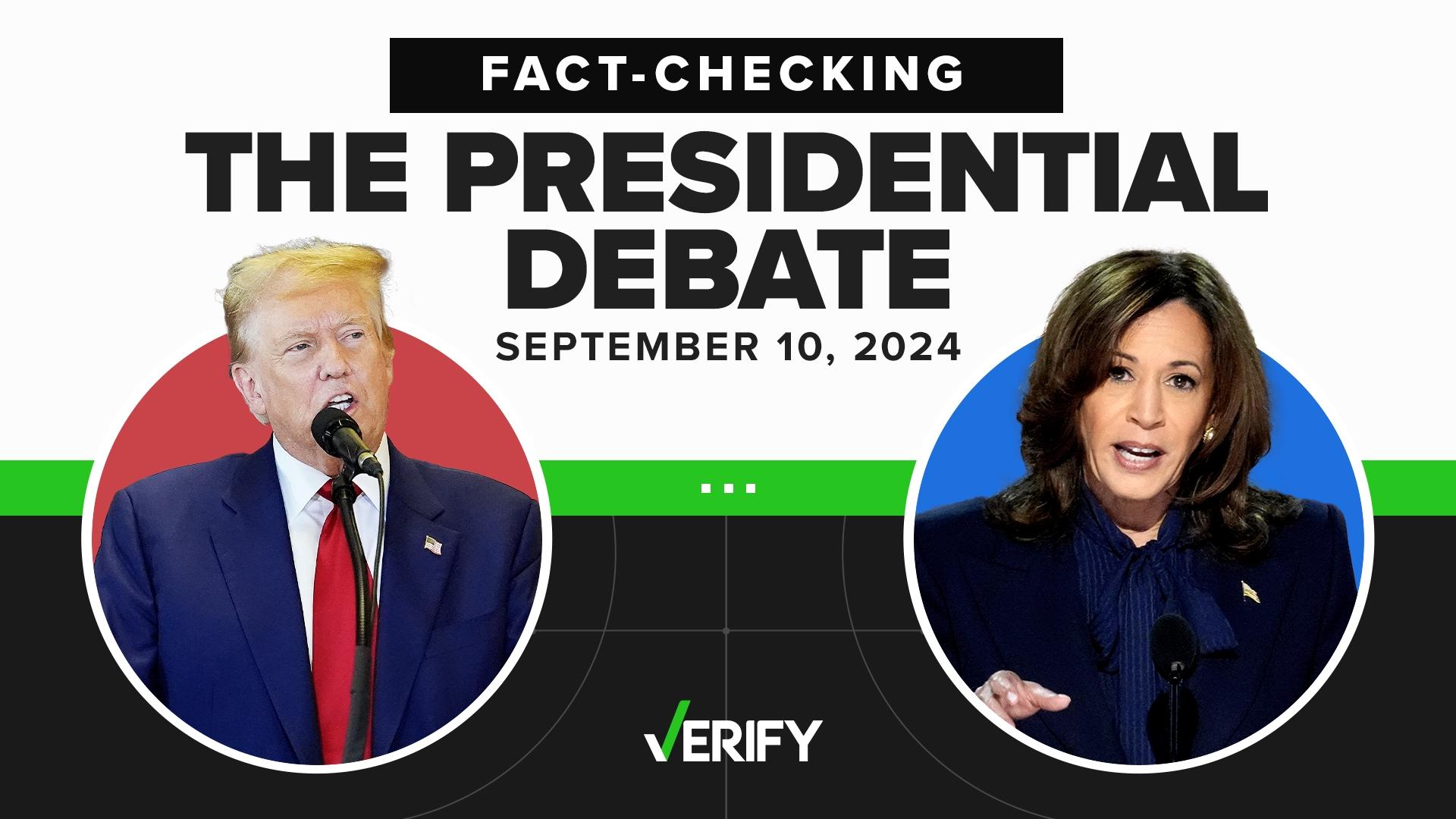Vice President Kamala Harris and former President Donald Trump met on the debate stage for the first time in Philadelphia on Tuesday, Sept. 10.
The presidential debate, which was held at the National Constitution Center, may be Harris’ and Trump’s only debate ahead of the 2024 presidential election in November.
During the debate, the two candidates sparred over issues including foreign policy, crime, immigration and abortion.
VERIFY analyzed several claims that Harris and Trump made during the debate.
THE CLAIM
Harris: “My opponent has a plan that I call the Trump sales tax, which would be a 20% tax on everyday goods that you rely on to get through the month. Economists have said that Trump sales tax would actually result for middle-class families in about $4,000 more a year.”
THE SOURCES
- Council on Foreign Relations
- Center for American Progress (CAP) Action Fund
- Erica York, a senior economist with the nonpartisan Tax Foundation Center’s for Tax Policy
THE ANSWER
Harris was likening Trump’s proposal to impose a tariff of 20% on all imports to a “national sales tax.”
Tariffs are taxes that countries impose on imported goods when they cross the border. They are paid by the business or individual importing the goods. This is different from a national sales tax that would be applied to everything Americans buy at the time of purchase.
However, economists say the costs of tariffs are largely passed on to consumers, according to the Council on Foreign Relations. The number Harris shared about the increase in costs for middle-class families as a result of Trump’s proposed tariffs is accurate based on some economists’ estimates.
The Center for American Progress (CAP) Action Fund, a progressive advocacy group, estimates that a 20% across-the-board import tax combined with a 60% tax on Chinese goods that Trump has also proposed would amount to about a $3,900 tax increase for a middle-income family.
“The methodology Center for American Progress uses is a good way to estimate the tariff burden for median households,” Erica York, a senior economist with the nonpartisan Tax Foundation’s Center for Tax Policy, told VERIFY.
THE CLAIM
Trump: “In Springfield, they're eating the dogs, the people that came in, they're eating the cats. They're eating the pets of the people that live there.”
THE SOURCES
- Karen Graves, a spokesperson with the City of Springfield, Ohio
- Sept. 9 report from the Springfield News-Sun
- Leann Castillo, executive director for the Clark County Park District
THE ANSWER
There is no evidence to support recent claims that members of the Haitian immigrant community in Springfield, Ohio, have harmed or eaten wildlife or pets, according to city officials.
“In response to recent rumors alleging criminal activity by the immigrant population in our city, we wish to clarify that there have been no credible reports or specific claims of pets being harmed, injured or abused by individuals within the immigrant community,” Karen Graves, a spokesperson with the City of Springfield told VERIFY.
“Additionally, there have been no verified instances of immigrants engaging in illegal activities such as squatting or littering in front of residents’ homes. Furthermore, no reports have been made regarding members of the immigrant community deliberately disrupting traffic,” Graves said.
The Springfield Police Division said they haven’t received reports of pets being stolen and eaten, the Springfield News-Sun reported.
Leann Castillo, the executive director for the Clark County Park District, told VERIFY there has been “no evidence or reports of this happening in the parks in Clark County,” where Springfield is located. Castillo said the parks office has been receiving inquiries about the claim, but they “do not have any knowledge of this taking place.”
THE CLAIM
Harris: “I made that very clear in 2020. I will not ban fracking. I have not banned fracking as vice president.”
THE SOURCES
THE ANSWER
It’s true that Vice President Kamala Harris does not currently support banning fracking. But that hasn’t always been the case, as Trump pointed out during the 2024 presidential debate.
During a 2019 CNN town hall, Harris, who was a Democratic presidential primary candidate, said, “There’s no question I’m in favor of banning fracking.”
But, when she was picked as current President Joe Biden’s running mate in 2020, Harris aligned with Biden’s position on fracking.
“Joe Biden will not end fracking. He’s been very clear on that,” she said during a vice presidential debate at the University of Utah in October 2020.
During an interview in August 2024, CNN’s Dana Bash asked Harris if she still wanted to ban fracking after her 2019 comments. In response, Harris said, “No, and I made that clear on the debate stage in 2020, that I would not ban fracking. As vice president, I did not ban fracking. As president, I will not ban fracking.”
THE CLAIM
Trump: “I had tariffs, and yet I had no inflation."
THE SOURCES
THE ANSWER
There was inflation during Donald Trump’s presidency.
Inflation is an increase in prices. The U.S. Bureau of Labor Statistics measures prices via the Consumer Price Index, a figure that represents the relative cost of a basket of common goods.
In January 2017, when Trump took office, the Consumer Price Index was 242.839. In January 2021, when Trump left office, the index sat at 261.582.
That means prices went up by 7.7% over four years, an average of 1.9% annual inflation during Trump’s term.
The Federal Reserve generally considers 2% inflation to be the goal of a healthy and stable economy.
THE CLAIM
Trump: “I got more votes [in 2020] … than any sitting president in history, by far.”
THE SOURCES
THE ANSWER
Former President Donald Trump did get more votes than any sitting president in U.S. history. However, Joe Biden, who was not in office at the time, received even more votes in 2020 and won the presidential election.
More people voted in 2020 than any other presidential election in history. Just over 74 million people voted for Trump in 2020, according to the Federal Elections Commission (FEC). That was 46.85% of the total votes. Biden earned 81 million votes, or 51.31% of total votes.
Trump’s total was the most ever for a Republican or sitting president, while Biden’s total was the most ever for any presidential candidate in U.S. history. The reason for this is that there are more people of voting age in the U.S. than ever before, and the 2020 election had a historically high turnout.
The FEC says there were over 158 million votes cast in the 2020 U.S. presidential election. It estimated a total voter turnout of 62.8%.
Prior to the 2020 election, the most votes for a Republican presidential candidate was just under 62 million votes for Trump in 2016, which was 46.09% of the 136 million votes cast in that election.
The most for a sitting president came in 2012, when former President Barack Obama received just under 66 million votes, or 51.06% of the 129 million votes cast.
Since 1980, the largest vote share for a presidential candidate is former President Ronald Reagan’s 58.8% share of the vote in 1984, according to the UCSB’s American Presidency Project. Ronald Reagan was a Republican and a sitting president in that election.
But Reagan did not receive more total votes than Trump, even with a 12% increase in vote share. The FEC says Reagan earned 54 million of the 92 million votes cast in 1984.
THE CLAIM
Trump: “I have nothing to do with Project 2025.”
THE SOURCES
- Project 2025 policy plan,“Mandate for Leadership: A Conservative Promise”
- Donald Trump’s Truth Social posts
- A July 2024 statement from Trump’s campaign
- An X post from Project 2025’s official account
- Rumble video of Trump’s speech at the Heritage Foundation’s 2022 Annual Leadership Conference
THE ANSWER
Former President Donald Trump has repeatedly denied any connection to Project 2025, which is a plan for the next conservative president. However, he has previously supported the organization behind the initiative and multiple former Trump administration members have either contributed to or supported it.
In multiple Truth Social posts, Trump has stated he has no knowledge of Project 2025, and his campaign also denied any connection in a statement.
"President Trump’s campaign has been very clear for over a year that Project 2025 had nothing to do with the campaign, did not speak for the campaign, and should not be associated with the campaign or the President in any way,” the statement said.
The Project 2025 team has also stated that it's “not affiliated with former President Trump.”
Although both Trump and the Project 2025 team say they are unaffiliated, multiple members of his presidential administration and campaign either contributed to or shared support for Project 2025.
This includes Paul Dans, who was Trump’s chief of staff in the U.S. Office of Personnel Management and director of Project 2025 at the Heritage Foundation until he stepped down in late July, and Trump’s current campaign press secretary Karoline Leavitt, who made an appearance in a promotional video for a Project 2025 initiative last year.
Trump has also previously supported the Heritage Foundation, the organization behind Project 2025, in a 2022 speech at the group’s Annual Leadership Conference.
“This is a great group, and they’re going to lay the groundwork and detail plans for exactly what our movement will do and what your movement will do when the American people give us a colossal mandate to save America. And that’s what’s coming,” he stated.
THE CLAIM
Harris: “Nowhere in America is a woman carrying a pregnancy to term and asking for an abortion, that is not happening. It's insulting to the women of America.”
THE SOURCES
- KFF, a health policy organization
- Healthline
- WebMD
- Centers for Disease Control and Prevention (CDC)
THE ANSWER
There are no abortions that take place in the U.S. moments before birth or “after-birth.” “Post-birth” abortions are actually classified as infanticide, which is illegal throughout the United States.
KFF, a health policy organization, says that abortions “moments before birth” or “after birth” do not occur and are not legal in the United States.
Neither Healthline or WebMD include “after-birth” abortions among their list of available abortion procedures in the United States.
According to the Centers for Disease Control and Prevention (CDC), less than 1% of all abortions in the U.S. happen after 21 weeks of gestation.
Experts also told the Associated Press that it is not physically possible to perform an abortion if a woman has already gone into labor.
“Patients who are laboring at term are never having an abortion,” Sarah Prager, M.D., a professor of obstetrics and gynecology at the University of Washington, told the AP. “They are having a delivery.”
This story is also available in Spanish / Lee este artículo también en español: Verificamos afirmaciones del debate presidencial entre Harris y Trump












